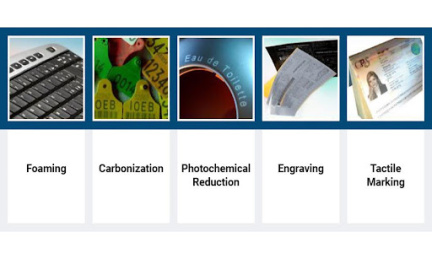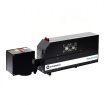Laser marking is literally everywhere - from the keys on laptops and car dashboards to the milk carton in the fridge, the logo on golf clubs to the instruments used by surgeons. In fact, marking is one of the biggest uses of lasers today because it has many advantages over other methods such as printing. As an example, lasers can easily create a permanent mark on most materials that will not peel or smudge, even with frequent handling.
How does laser marking work?
If laser marking really is everywhere, does that mean that anything can be marked with a laser? Not anything, but the vast majority of materials can indeed be laser marked. You just need to choose the right type of laser. Even diamond, the hardest known material, can be marked with a laser. And why is laser marking so important? Laser marking creates a small but indelible mark on a material, such as a diamond. The laser mark does not add any material such as ink or colour and so does not change the properties or composition of the original product, yet the laser mark allows each product to be uniquely identified, helping to reduce confusion or fraud. Of course, laser marking is also used for product branding, creating descriptions and functional marks - for example, control labels, numbering scales on a product, etc.
But if the laser doesn't add any color or other material to the object, how can it mark anything?
That depends on the product - what material it is made of, what the mark is supposed to look like, and how it will be used. In the broadest sense, however, all laser marking basically falls into just two categories:
- Laser markings that involve removing or changing the surface texture.
- Laser marks that create a colour or contrast change to the surface
1) Laser engraving - marking with removal or alteration of the surface texture of the product
Laser engraving is similar to mechanical engraving. In engraving, part of the material is removed, in this case the laser burns or vaporizes part of the material where it hits the surface of the product. Making a mark therefore involves moving (or scanning) the beam across the material to engrave the desired letters, numbers, barcode or graphics. Sometimes the grooves created are then filled with a material that contrasts with the colour of the original surface to make them more visible, just like traditional engraving. This is the simplest method of laser marking, but also offers a very high speed of work. The disadvantage of this method is the distortion of the surface of the product. Nevertheless, for many applications this method is sufficient and often used.
Related products:
2) Laser marking - marking involving colour change of the product surface
The second method of laser marking is marking that only changes the colour of the product surface without disturbing it. There are quite a few different ways to use the laser to perform this colour change depending on the material being marked. In almost all cases, the idea is to create a high-contrast mark without damaging the surface, which can then be easily read either by a person, by a handheld reader (for example, a barcode or QR code or a mobile phone) or by other means of machine vision. Laser marking involves several methods:
(a) Laser carbonisation
For white and transparent plastics, a laser can create a dark mark by heating and carbonising the material. Laser carbonisation is a process used for marking organic materials or synthetic polymers and some ceramics. Carbonization of organic materials involves the conversion of organic matter into carbon. When the material is exposed to the energy of the laser beam, it carbonises extremely quickly and turns into solid carbon. In the case of marking plastics, the laser beam penetrates the material and is absorbed by the colour pigments. When the pigments change chemically, this causes the material to change colour. Because the laser beam penetrates the plastic, the surface of the material remains virtually undamaged. The colour change depends on both the pigment and the base material. Laser carbonization of plastics is usually performed on light and clear polymers and results in a dark or gray laser mark.
Laser carbonisation is also often used for wood marking, for example in the production of souvenirs, logos, signs and notice boards, etc.
Related products:
b) Laser foaming and tactile marking
Laser foaming is used for marking plastics and polymeric materials. It is actually a combination of engraving and colour change. In foaming, the laser brings a small amount of material to a boil and it cools down in the form of tiny foam bubbles. These bubbles are firmly fixed in the material structure and create a negative relief where the laser beam hits the material. Laser foaming is most commonly used in the production of packaging materials and in the automotive industry. It is also used extensively to produce white or light-coloured marks on dark-coloured plastics such as computer keys.
The laser can also be used to create tactile markings. This marking works on the same principle as laser foaming, but results in a higher relief of the mark created. The mark thus created can then be felt by anyone, including the visually impaired.
Related products:
c) Laser marking using photochemical reduction
In contrast, coloured and dark plastics can be photo-dyed using a laser. This means that the plastic can fade or become lighter in colour under the action of the laser. And the same laser bleaching method is used to create almost all popular wear and damage patterns on jeans. The advantage of this method is that the action of the laser is entirely photochemical with no thermal component. Thus, there are no changes to the material due to heat.
An interesting application of this type of marking is marking into the 'interlayer' of the material. The principle is very simple. It is always marked on a sandwich material, where the upper layer of the material is transparent to the laser beam of a given wavelength. The beam passes through this layer and reacts only in the next layer, where it creates the desired colour change. The result is a laser mark "inside" the material. This makes the mark itself both very attractive in design and resistant to damage.
Related products:
d) Black laser marking - the latest in metal marking technology
Lasers can also perform colour changes on metals. One relatively new method of marking metals is called "Laser Black Marking" and is very popular for reusable medical devices such as surgical instruments and endoscopes. In this case, an ultrashort pulsed (USP) laser causes microscopic structural changes on the surface of the metal. The altered metal surface then does not reflect light and appears black from all angles. Nevertheless, the material is not burnt and there is no structure visible on the marking that can be palpated. The advantage of this method of marking the metal is that it does not need to be passivated and is not subject to change even when the instruments are sterilised.
Manufacturers of some premium electronic equipment use the same method to mark logos and serial numbers on their products because this method of marking cannot be easily forged or altered.
Related products:
Customizing a marking system to a specific application
The specific laser and its configuration to be used for a particular laser marking job depends not only on the material, the desired mark appearance and the required marking capacity. Just as there are many types of materials, there are also many types of specific lasers that can achieve different results even on the same material. That's why Coherent offers a wide selection of laser marking systems to help you choose the best model for each application. If you are looking to integrate laser marking into a new or existing production line, Coherent offers a comprehensive range of laser subsystemsfor simple and easy integration, including integration support.
Find out how Coherent's Application Lab can help you choose the right laser type: COHERENT APPLICATION LABORATORY











